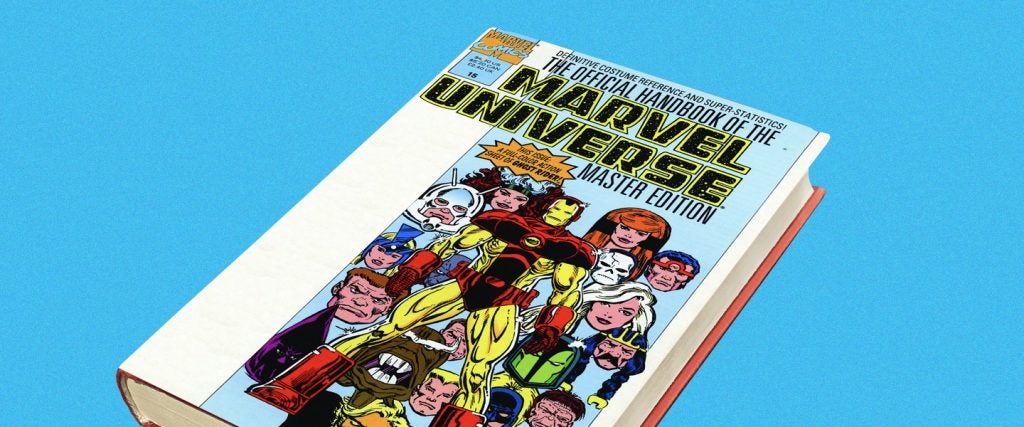Even when I was only a six-year-old kid buying unwanted copies of The Invaders from the 10-cent box at the Classic Movies & Comics Center in Livonia, Michigan, I absolutely adored the Official Handbook of the Marvel Universe. The series was a perfect way for me to get acquainted with the history of Marvel Comics without having to spend tens of thousands of dollars on back issues.
Better yet, the handbooks — one part baseball card, one part encyclopedia — provided a litany of remarkable stats and information on each and every Marvel character: from the science behind their superpowers to exactly how much weight they could lift. Particularly in this regard, their attention to detail was exquisite (even if the science bolstering it was fairly far-fetched). So exquisite, in fact, that it fueled endless debates among comic book nerds like myself about who was stronger than who and who could beat who in a fight.

Case in point: I loved the Thing. And so, while the handbook listed the Hulk as stronger than the Thing, it also said the Thing had been trained in hand-to-hand combat. Therefore, with this knowledge in hand, I reasoned that maybe the Thing could get a win over the Hulk anyway by using his other attributes outside of his raw strength.
One man, of course, who can settle such debates (as well as inflame them further) is Tom Brevoort, the executive editor and senior vice president of publishing at Marvel Comics. Given the Marvel Universe we all live in these days, I recently caught up with him to help me determine whether or not the Thing could ever overpower the Hulk, why it’s unclear if each character’s strength is measured via deadlift or bench press and how Spider-Man can lift 10 tons one day and only five tons another.

When did you first come across the Marvel Universe handbooks?
As soon as they were released, I bought the earliest issues back in 1982. Whenever the initial handbooks came out, I bought them.
Do you remember having any strong feelings at the time with respect to the way the books defined, explained or limited the Marvel characters’ powers?
Yes, particularly when the DC equivalent Who’s Who? came out. The big difference between the two and their approaches is that the Official Handbook of the Marvel Universe spent a lot of time trying to justify the scientific manner in which all these powers worked. On a certain level that’s absurd, because they all violate the laws of physics. Explaining in minute detail things like the force ratio of Cyclops’ eye beams and how they operate so that he’s not blown backwards every time he opens his eyes was primed to create a sense of verisimilitude, but it went to ridiculous lengths.
In DC’s Who’s Who? their entries on powers were much simpler. DC would say, “The Flash can run fast. Really fast. About this fast.” The Marvel equivalent would be “Quicksilver’s body allows him to expel fatigue waste through his breath.” There was a lot more gobbledygook in it as they’re attempting to make plausible all of this stuff that frankly isn’t plausible. There were a lot of people who really liked that and enjoyed that approach.
For me, I didn’t need to understand how Quicksilver expelled fatigue waste. “Quicksilver can run fast” is enough for me. There is a level at which I want to understand how it works, but in his case, all I need to know is that he puts one foot in front of the other really really quickly. Beyond that, I don’t need to know, because no one can really do any of these things. It’s a lot of argle-bargle, made-up nonsense to make it seem more plausible that this stuff could actually happen when it absolutely cannot.
I’ve heard that the two main reasons that Marvel released the handbooks was to establish expectations for the readers as far as what characters were capable of doing, and also to rein in the writers somewhat so that we wouldn’t see anything like Hawkeye punching out Thor.
When the handbook was created in the 1980s and extended into the 1990s, it served two functions simultaneously. One, it was a saleable product that Marvel readers were interested in and wanted, and that Marvel made a lot of profit on. It was a product along the lines of Dungeons & Dragons handbooks and other catalogs of that sort. It was intended as a catalog. It wasn’t really designed to generate new information, although a lot of information was generated along the lines of doing it.
The secondary use it was designed for was to be an in-house reference source. When I started in 1989 and for a couple years thereafter, every editorial office had a full set of the trade paperbacks of them. If they needed to use a character or they needed a costume reference or whatever, so much of it was in there.
I don’t think it was specifically designed to set readers’ expectations. It was trying to clarify. Spider-Man had been in hundreds of stories by that point. Sometimes he did things that were really strong, and sometimes he did things that were only slightly strong. Quantifying that down to some calculation was a part of it, but it wasn’t to specifically keep people from being imaginative or doing stories or what not. It was to collect all the stuff that had been done and put it in an easy, digestible form so that people could read it, absorb it and use it going forward.
I recall a Captain America issue where the characters seemed to be quoting their stats straight out of the handbook. Demolition Man grabs Titania and says he can press 15 tons, and Titania replies by saying she can press 85 tons before chucking him off a cliff. It seemed strange to me that super characters would be that in tune with how exact their individual strength stats were.
The thing that you have to understand is that issue of Captain America was written by Mark Gruenwald. Mark was the editor and overseer of the Marvel Universe handbook. Not only did he know all that stuff inside and out and care about that stuff inside and out, he also wasn’t above having fun with it. I don’t think Mark intended that exchange to be a serious exchange of stats between characters. I think it was him being goofy with the fact that they’re establishing this stuff. He’d been writing the term “lift (press) 20 tons” for weeks on end as a part of this handbook, so it was just a dopey bit of business as the characters fought in that issue because that’s where his head was at that day.
I’m glad you brought up the “lift (press)” phrasing, because it has caused a lot of debate online. I’ve seen “lift” quoted as if deadlifts are being discussed, then I’ve seen “press” discussed as if it could be a strict overhead press, a snatch or a bench press. Did you get any sense of what Gruenwald intended to be meant by “lift (press)” when it was used in the handbook over and over again?
When Mark was talking about “lift (press)” he seemed to be talking about a bench press situation. What he was really trying to do was create a level playing field. If you take outside circumstances out of this equation, and you just have a character and a bunch of weight — in this case the character is on a bench because that was a typical measurement of strength in different sporting arenas — that was a way that you could quantify how much Spider-Man can lift in comparison to Daredevil, the Hulk or whomever, if you eliminated all other factors from that measurement. I don’t know how precise Mark was about that. He might have been thinking of it as a deadlift, but the way he described it made me think that this was in a controlled gym environment; nobody is attacking the character, and no one is under duress. They’re lying on their back with a bar and a lot of weight, and this is how much they can pick up.
One of the things that happened inevitably is what we used to call “stat drift.” An example would be how Spider-Man can lift — I’m going to guess off the top of my head — 10 tons. The reason Spider-Man can lift 10 tons is because there’s a very early Spider-Man story by Steve Ditko in which Spider-Man is trapped under this enormous piece of machinery, and he had to lift it off of his back. Mark looked at that and estimated that it had to weigh at least 10 tons. That story puts Spider-Man in an extreme situation where he digs down and finds the gumption and the wherewithal to free himself of this thing that he ordinarily wouldn’t be able to free himself from. Well, that translated as a stat to 10 tons.
From that point forward, fans would look back on that and define it as, “Spider-Man can lift 10 tons without breaking a sweat,” and then they’d ask us questions like, “How can Spider-Man be fighting Kingpin, who is just a guy, when he can lift 10 tons?!?!” But that was meant to represent the absolute upper limit of his strength. On a regular day, maybe it would only be five tons that he could lug around.
Fans also have to remember that what we really do at Marvel is storytelling. And storytelling isn’t about the stats. The handbook should be used as a tool in crafting stories. It shouldn’t be seen as a straightjacket preventing storytelling. There are any number of Marvel stories where the guy who is theoretically less strong based solely on the numbers wins out over the guy who is theoretically stronger. And they’re supposed to!
Heroes are only as good as the people they fight, and they should always be up against guys who are stronger or more powerful than they are so that they can prove their value, their moxie, their bravery and their cleverness in finding ways to win out even though they’re overmatched. For years and years and years, I’ve heard from fans online about the stats, and I’ll say, “That’s all well and good, but that’s not how it works.”
At the end of the day, if the Thing has his name on the cover of the book and the Hulk doesn’t, then the stats don’t matter; the Thing is coming out on top. That’s the story that you’re buying, not the numbers that are on a chart somewhere.

